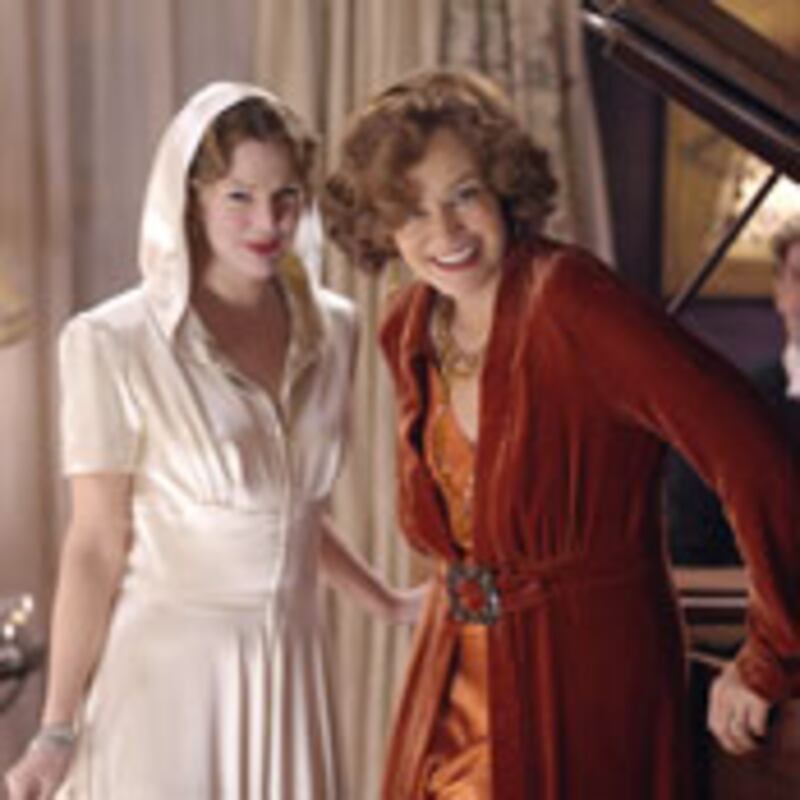
Imagine the ghost of Little Edie Beale. She’s fluttering over the red carpet at tonight’s overbooked, glittery premiere of Grey Gardens , HBO’s terrific drama based on Albert and David Maysles’ documentary about Edie and her mother—those now-culty figures who bicker, sing, and live in isolated squalor in their crawling-with-cats house. I see Ghost Edie as she appears in the opening of The Beales of Grey Gardens, the film of outtakes from the 1976 documentary that Albert Maysles compiled a few years ago: Wearing pink scarves tied into a sarong and a red print scarf on her head, she steps onto the front porch and sings an oddly mournful version of “You Ought to Be in Pictures.” Edie always assumed she was meant to be a star.
“We need the Beales to seem off-kilter today, assurance that for ordinary people setbacks like a tanking economy won’t lead to life with Mom and raccoons.”
No one could have foreseen the cockeyed path of her fame, though, or the persistence of Grey Gardens, which hits so many cultural nerves it gains significance as the decades roll on. The new drama is more than just a showcase for brilliantly deep performances by Drew Barrymore as Little Edie and Jessica Lange as Big Edie, aging from the 1930s through the '70s. Taking cues from the original documentary, the new Grey Gardens is partly about fame. The HBO tagline, echoing newspaper headlines of the day, is “Inside the Incredible World of Jackie’s O’s Relatives;” who would have paid attention otherwise? It’s also partly about voyeurism: Here David and Albert Maysles appear as minor characters and occasionally roll their eyes behind the Beales’ backs. (Who can blame them? They have to put flea collars around their ankles before entering the dilapidated house.) We—entertained, judgmental viewers—are implicated in this unsettling intrusion, the predecessor of so much reality television.
Perhaps most of all, we are still drawn to the Beales by one endlessly fascinating question: How did two socially prominent women turn into crazy cat ladies? Their downward spiral carries extra resonance today, with fortunes tumbling all around us.
Let’s not be coy about how loopy the Beales were. Grey Gardens cultists insist they weren’t cracked, just eccentric. This theory makes Little Edie, with her upside-down skirts and cardigans as hats, a fashion trendsetter, as if she were some Emily Dickinson of designers, putting together costumes that would only be appreciated after her death. (“This is my sweater-on-my-head to the world/ That never wrote to me.”)
But the horrendous, garbage-strewn house was not some artistic quirk. Even Lange, in an interview with Entertainment Weekly, couldn’t fathom the mystery of those empty cat-food cans piled up in the living room. “Why don’t you put them in a garbage bag?” she wondered. “It’s not that hard.”
The film does more than the documentary or the Broadway musical (which debuted in 2006) to fill in the gap between the two beautiful women we meet in 1936 and the social outcasts we see 40years later, when elderly Big Edie stays in bed and boils corn on a hotplate on her night table, and middle-aged Little Edie manically waves a flag as she dances and flirts with the Maysles.
The Maysles’ documentary doesn’t explore what went wrong with the women over time; it offers raw, partial evidence, handing us the Beales as a puzzle. The musical simply lets the women morph from young beauties to near-recluses during intermission.
But that nagging “How did it happen?” is central in this film’s script by its stylish first-time director Michael Sucsy and Patricia Rozema (writer/director of a smart film version of Mansfield Park). In middle age, Big Edie is frustrated because she wants a singing career, yet pushes Little Edie—with showbiz dreams of her own—toward marriage. “Find a man who will give you a long leash,” Big Edie says. “Get married and then you can do whatever you want.”
They are stifled by a society that doesn’t allow upper-class women to be more than elegant hostesses, but there are personal warning signs, too. We see glimmers—subtle but definite—of the Beales’ too-intense reaction to failure and rejection. At a turning point in the ‘30s, Big and Little Edie dance to entertain their party guests, only to have the imperious Mr. Beale (played by Ken Howard) show up and declare the party over.
“Beyond tricks of makeup and mimicry, they allow us to feel the weight of all those years of love, resentment, and disappointment.”
Little Edie, on her own in New York, has an affair with a powerful, Daddy-like married man (Daniel Baldwin), and is crushed when he says she was just a fling. She runs home—permanently as it turns out—to her East Hampton home, Grey Gardens, where Big Edie is already lounging in depressed loneliness on her bed. From then on, their unhealthy symbiosis never lets up. The craziness was incipient, and the shattered dreams—of show business and romance—push them into Grey Gardens as if it were some crumbling fairy-tale castle that held them in its spell. Nothing outside was safe.
Yes, the film’s explanation may be too neat, and after all it’s fiction. Who can ever know why they cracked? But this astute psychology gives the drama a satisfying completeness.
As the women age and the actresses sag with prosthetics, their faces mirror the disintegration of the house itself. Lange is unrecognizable in a white wig and bad teeth, and both women’s Social Register accents are perfection. But beyond tricks of makeup and mimicry, they allow us to feel the weight of all those years of love, resentment, and disappointment.
And the drama echoes what may be the secret of the Edies’ enduring appeal: their utter lack of self-pity. By facing the Maysles’ cameras with such assurance they are strangely strong and endearing even as we judge them to be off-kilter. (And we need them to seem off-kilter today, assurance that for ordinary people setbacks like a tanking economy won’t lead to life with Mom and raccoons.)
Little Edie was shrewd about putting herself on screen. She explains in The Beales of Grey Gardens why “I’m mad about the Maysles.” Earlier, she had been approached by a movie company’s rep who thought Julie Christie should play her character. Edie sent him packing; only she would play herself. How appropriate that a woman caught in such a destructive symbiosis with her mother and a more productive symbiosis with the Maysles would intuit the heart of reality TV. The documentary Grey Gardens is a model for that mutually exploitative genre, in which real-life characters play themselves in exchange for fame.
So let’s guess that Edie’s ghost might be happy at the starry crowd that promises to show up tonight to see her fictional self. (Along with Lange and Barrymore, the guest list includes Anne Hathaway, Albert Maysles, and Sally Quinn and Ben Bradlee, who now live in Grey Gardens), and that Barrymore’s amazing, sympathetic performance gives her every reason to smile.
Grey Gardens premieres on HBO at 8pm EST, April 18
READ MORE: The Daily Beast interviews Grey Gardens star Drew Barrymore
Caryn James is film critic for Marie Claire magazine and contributes to T he New York Times Book Review. Formerly, she was a film critic, chief television critic, and critic-at-large for The New York Times, and an editor at the Times Book Review. She is the author of the novels Glorie and What Caroline Knew.





